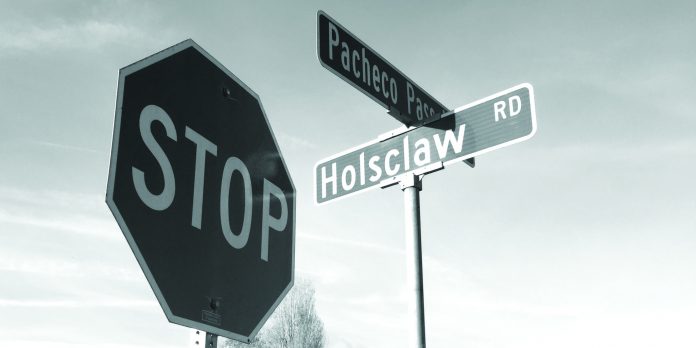This is the story of three brothers who left their 11 siblings and parents at a northwest Missouri homestead in 1849 to head west to California, in search of gold.
There is no record of how they got to the Golden State, except that it took them less than a month, probably traveling by stagecoach. The completion of the transcontinental railroad was 20 years in the future.
The brothers—Clifton Holsclaw, the oldest at 24, Milton, 22 and James, perhaps 19—did not get rich in the California Gold Rush. But by standards of the day, they became wealthy. In Diamond Springs, “they erected the second house in that place, established a provision depot and made it their headquarters, also engaging in the mining in the Martinez and Weber creeks.” In the first four months of 1851, the three brothers were earning $40 to $50 per day each, according to J.P. Munro-Fraser’s 1881 account of the history of Santa Clara County. That’s about $1,500 a day in 2018 dollars.
Milton invested his new fortune in new businesses. His brothers were more restless, “joining the forces sent to meet the Indians.” The brothers would be separated for about two months, during which time Clifton and James would get a foretelling taste of battle and guerilla-style combat, and Milton began a freight-hauling business from Sacramento to Grass Valley, Yuba and Placerville.
“In the month of June he laid in a stock of provisions, and proceeding to Shasta City, sold them, but so bold were the natives that he had to stand guard over his mules in the very heart of town,” wrote Munro-Fraser.
The trio headed south in search of safer settlements, visiting Stockton, Livermore, Mission San Jose, San Jose City and eventually Gilroy, even then an important transportation crossroads in the Santa Clara valley. They decided to make Gilroy their new home.
James and Milton were “the first two members of a Protestant Church to locate there,” according to Munro-Fraser. The brothers opened their house as a boarding house for “all Christian denominations,” including the first meeting of the South Methodist Church in 1853.
Milton had learned blacksmith skills on the farm in Missouri, and in the fall of 1851 opened Gilroy’s first blacksmith shop. The brothers also bought land along a small creek now known as Llagas Creek, and began farming on the rich soils of the bottom land. The following year, the Holsclaw brothers made use of their Missouri farming skills and grew the first crop of wheat in the Gilroy District of Santa Clara County, which they would sell in Alviso for eight cents per pound.
“In the following year they added barley to their productions, and manufactured some flour, which they disposed of in a radius of 30 miles, on credit, to all that wanted bread,” reported Munro-Fraser. “The honesty of the settlers is fully borne out by Mr. Holsclaw’s statement that out of $6,000 worth of produce thus sold, he only lost $16.”
Milton moved to a larger farm nearby, and by 1854 became Constable of Gilroy township. He bought and sold farm property and houses four more times in the next five years, including one lot later occupied by Gilroy’s first rail depot.
As Milton settled into politics and real estate and business development, his brothers grew restless once again. They were following accounts of the inter-state war raging at that time between Kansas and Missouri, and heard romantic tales of their family’s Missouri neighbors, the Quantrills, the Daltons and the James brothers who had begun waging a vicious guerrilla war against border towns of free-state Kansas before the start of the Civil War.
The Holsclaw brothers no doubt were worried about the safety of their aging parents, their five sisters—and the need to preserve the family homestead, including its “property” of 11 slaves. Add to this their brief but successful stint with the California militia battling Native Americans north of Sacramento, and Clifton and James bade Milton farewell and headed back to northwest Missouri in 1859.
Milton’s farmstead grew, and he prospered in Old Gilroy as a farmer through most of the 1860s, when Gilroy would grow to more than 1,000 people.
Eighteen hundred miles east, the Holsclaw homestead in Howard County, Missouri, contrasted sharply with Milton’s peaceful, bustling, optimistic new hometown in post-Gold Rush California. The war would leave Confederate Missouri increasingly isolated and surrounded, and the glamorous guerillas of the late 1850s would be hunted by Union troops as thieves, murderers and terrorists. The brothers’ family would never be the same.
There is no record of any of the Missouri Holsclaws returning to California after the war, or if Milton heard of the terrible tragedies that would befall his family in the war years. The separation was apparently so great that Reconstruction-era histories and accounts of his family and his brothers—bushwhackers hailed as heroes of the Confederacy 150 years later—often excluded any mention at all of the prosperous California brother.
Clifton would go on to become a Captain in the Missouri State Guard. He, James and three other brothers would enlist in the doomed campaign against the Union Army. Clifton and James were both wounded and their brothers William, John and Benjamin were killed in the war, two of them at the Battle of Vicksburg.
Milton’s Missouri family menbers were all involved in the war effort. One of his sisters, Mary, was killed in 1862 while trying to dry gunpowder for her brothers. When Union soldiers on the trail of bushwhackers stopped by the Holsclaw farm in Howard County looking for Clifton, patriarch James defied them and was shot dead in his front yard in front of his wife and several daughters.
Clifton’s discovery of his father’s death at the hands of Union soldiers transformed his war to one of personal revenge, and he formed a legendary guerilla unit allied with “Bloody Bill” Anderson that defended its turf with a take-no-prisoners approach.
After the war, when the James and Dalton guerillas and other Quantrill alumni continued their battles as outlaws, Clifton returned to his agricultural roots, as a farmer. James became a school teacher.
It is possible that Milton Holsclaw never knew of his father’s or brothers’ fate. He had 10 children, but most would not live to adulthood. Some settled around the town, then spread north to San Jose.
He moved outside of Old Gilroy in 1875 and returned to a farm along Llagas Creek, where he would live to see the dawn of a new century. He died in 1902, and is buried with his wife Mary in the Gavilan Hills Cemetery. Four sons and a daughter-in-law also are buried there.
The 2.5-mile road that bordered his homestead along Llagas Creek bears his name. The next time you take that shortcut from Highway 152 to Leavesley Road, driving along a winding two-lane Holsclaw Road, know that you are traveling along a historic path where three pioneer brothers said farewell 160 years ago: One stayed behind to plant new roots in a new frontier, and two returned home to rebellion, bloodshed and tragedy.















